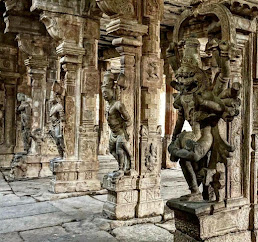Ancient Indian Architecture and Modern-Day Significance
India has, for ages, been a confluence point of many different schools of architecture. From the majestic Rajput forts to the sky-high south Indian temples and from the epitome of beauty Taj Mahal to the intricate cave temples of Ajanta and Ellora, the opulence of Indian architecture is mind-boggling. The South Indian temple architecture enjoys a unique position among the various architectural styles found in India and elsewhere.
Indian architecture, especially ranging to Vedic ages, has evolved over the centuries from simple rock-cut cave shrines to massive and ornate temples which spread across the Indian sub-continent and beyond, forming a canonical style. Careful practice of harmonious geometry, precise symmetry, and rock carving is observed in all ancient structures.
 |
| Ceiling Ranakpur Jain Temple |
The first materials used were wood and terracotta, but architects gradually moved on to brick and stone, especially sandstone, granite, schist, and marble. No mortar was used in the older temples and so precise cutting of dressed stones was required. Outstanding examples of influential cave structures include those at Udaigiri in Malwa and date to the 5th century CE. Early free-standing temples survive at Deogarh and include the 6th century CE Dasavatara temple and many more.
 |
| Mahabalipuram shore temple |
 |
| Lakshminarayana temple |
 |
| Dasavatra temple |
Intricate of story stone carving wherein stories of epics and velour were depicted on walls formed by large rocks was practiced. With limited resources, the amount of perfection achieved was miraculous.
The evolution of Indian Architecture as we know it began during the Gupta age. This age popularly known as the 'Golden Age of India, peaked around 400 AD. The surviving examples from this age like the one near Jabalpur in central India contain an inner Garba Griha surrounded by an ambulatory path, an outer portico with columns in the front, and a flat roof made of stone. Another similar architectural form evolved in the south of India almost contemporaneous to the Gupta architecture: the Chalukya dynasty, with its capital at Aihole situated in what is now Karnataka, built many temples with mostly flat roofs. The efforts of this dynasty gave rise to an important feature of the Hindu temple architecture: the inclusion of 'Mandapa' or pillared hall in front of the temple. From these early initiatives, the Hindu temple architecture evolved rapidly and differently, depending on the geographic locations. As mentioned before, the southern style, the northern style, and the hybrid styles came into being.
Some of the best examples of massive Hindu temples came into being as a result of the building spree of the Chola kings. The Brihadeshwara temple is the crowning glory that remains in a healthy state even after 1000 years of its construction. This is staggering indeed, considering the fact that the cupola of the Vimanam comprises two huge, sculpted granite blocks weighing 40 tonnes each! The stability of the structure can be attributed to the pyramidal structure, which has proved to be more robust than its counterparts from north India with their complex curvilinear profiles. The engineering skills and the expertise that made the mounting of these huge stones atop a structure that is nearly 200 feet high must have been way ahead of their times. Another fine example of the Chola temple architecture is the temple in Gangaikondacholapuram, which succeeded Tanjore as the capital of the Chola Empire. The Vimanam of this temple, in contrast to the rigid pyramidal structure of the Brihadeshwara temple, rises up in a concave manner with fluid lines.
 |
| Brihadeshwara temple |
 |
temple in Gangaikondacholapuram |
Beginning with humble caves and squat flat-roofed temples, Indian architecture, then, evolved over the centuries and, despite some regional variation, arrived at a standard arrangement that involved a huge walled complex with massive decorative gateways. The design has become so standard that it is copied even today in temples across the world from New Delhi to Malibu, California. Modern architecture, if inspired by the intricacy and detailing of Ancient times, would upheaval Indian designs across the world.









Comments
Post a Comment